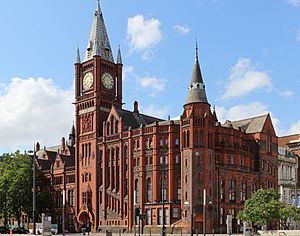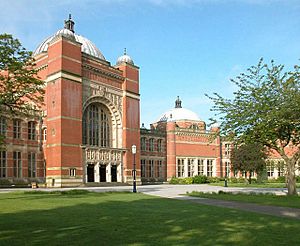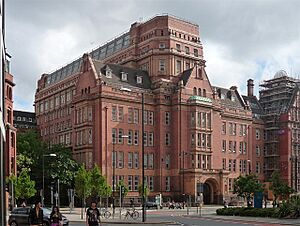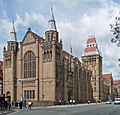Redbrick university facts for kids
A redbrick university is a name for certain universities in England. These schools were first started in the late 1800s in big industrial cities. They were called "redbrick" because many of their buildings were made of red brick. This was different from older universities, which were often built with stone.
Over time, the term "redbrick" sometimes includes other British universities. These are schools founded in major cities during the late 19th and early 20th centuries. Many of these universities focused on science and engineering. Eight of the nine original redbrick universities are now part of the Russell Group. This is a group of leading research universities in the UK.
Contents
What Does "Redbrick" Mean?
The name "redbrick" was first used by Edgar Allison Peers. He was a professor at the University of Liverpool. In 1943, he wrote a book called Redbrick University. He used the name to describe the new universities that were appearing in cities.
Why Red Brick?
The term "redbrick" came from the look of these new universities. The Victoria Building at the University of Liverpool is a good example. It was built in 1892 using bright red bricks. This made it stand out.
Older, more famous universities like Oxford and Cambridge were built with stone. Using bricks was cheaper and newer. At first, some people thought these new "redbrick" universities were not as good as the older ones. But they quickly became very important.
The University of Birmingham was the first of these city universities to become independent in 1900. Its main building also used a lot of red brick. This helped make the "redbrick" name popular.
How Redbrick Universities Started
The idea for these city universities began in the mid-1800s. Cities like Manchester, Birmingham, and Leeds needed more people trained in science and engineering. Factories and industries were growing fast.
These new university colleges were different from Oxford and Cambridge. Those older universities focused on subjects like history and literature. The new city colleges taught practical skills. They helped students get degrees through the University of London or by joining groups like the Victoria University.
Early Redbrick Universities
Many of these colleges grew into independent universities before World War I. Here are some examples:
- The University of Manchester started as Owens College in 1851. It became a university in 1903.
- The University of Birmingham began as Mason Science College in 1875. It became a university in 1900.
- The University of Leeds started as the Yorkshire College of Science in 1874. It became a university in 1904.
- University College, Bristol opened in 1876. It was one of the first in Britain to accept both men and women. It became the University of Bristol in 1909.
- University College, Liverpool was founded in 1881. It became the University of Liverpool in 1903.
- Firth College in Sheffield started in 1879. It became the University of Sheffield in 1905.
Other redbrick universities gained their independent status later. For example, Newcastle University became independent in 1963. The University of Reading became a university in 1926. The University of Nottingham became a university in 1948.
Other Similar Universities
Many other universities share similar features with the original redbrick schools. These include universities that started as local colleges and grew over time. Some examples are the University of Southampton, University of Hull, University of Exeter, University of Leicester, and Keele University.
Queen's University Belfast in Northern Ireland also fits the description. It became a university in 1908, around the same time as the English redbrick universities.
Today, universities in the UK are sometimes grouped into four types:
- Ancient universities: These are the oldest, founded before 1800 (like Oxford and Cambridge).
- Redbrick universities: Founded between 1800 and 1960.
- Plate glass universities: Built between 1960 and 1992. They often have modern, glass-fronted buildings.
- Post-1992 universities: These were polytechnics that became universities after 1992.
Images for kids














